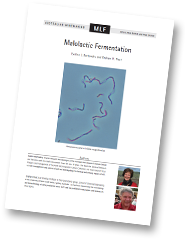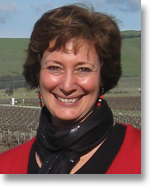It has been known since the early 1900s that, after alcoholic fermentation by yeasts, many wines undergo another fermentation which is widely known as the malolactic fermentation (MLF). This fermentation is conducted by lactic acid bacteria, and a key outcome is the deacidification of wine by the conversion of the di-carboxylic acid, L-malic acid, to L-lactic acid (a mono-carboxylic acid) through a decarboxylation reaction. For winemakers producing high acid wines, the MLF is a positive occurrence because this decrease in acidity softens the sensory character of an otherwise harsh, acid product.
A substantial amount of fundamental and applied research has been conducted on the MLF. Early studies focussed on the microbiology of MLF and factors that affected the occurrence and growth of malolactic bacteria in wines. These studies provided the foundations for subsequent biochemical, physiological and molecular research, designed to understand how malolactic bacteria grow in wine, how they change the chemical composition of wine and how these changes impact on wine sensory quality and acceptability. This chapter gives an overview of the importance of MLF in wine production, the scientific basis of the process and practical guidelines for its control and management in the winery.

$16.50Add to cart
Table of Contents
1 Introduction
2 Occurrence and significance of MLF
2.1 Occurrence and microbiology
2.2 Significance
2.2.1 Deacidification
2.2.2 Microbiological stability
2.2.3 Flavour and colour modification
2.3 Toxicological implications
3 Malolactic bacteria
3.1 Taxonomy
3.2 Cultivation of wine-related lactic acid bacteria
3.3 Biochemistry
3.4 Carbohydrates
3.5 Nitrogen compounds
3.6 Organic acids
3.7 Diacetyl
3.8 Phenolic compounds
3.9 Glycosidase activity
3.10 Ethanol and other wine components
3.11 Physiology
3.12 Molecular biology
4 Control and management of MLF
4.1 Natural MLF
4.2 Induction of MLF
4.3 Monitoring MLF
4.4 Controlling MLF
4.4.1 Sulfur dioxide
4.4.2 Acidity and pH
4.4.3 Ethanol
4.4.4 Sterilisation
4.4.5 Treatment of wine with chemical inhibitors
4.4.6 Treatment of wine with natural products
4.4.7 Lysozyme
4.4.8 Bacteriocins
4.5 New directions in MLF
5 Bioreactor technologies
6 Genetically modified yeasts
7 Conclusions
Authors

Eveline Bartowksy
http://www.awri.com.au/people/staff/eveline-bartowsky/Eveline Bartowksy is Senior Research Microbiologist at The Australian Wine Research Institute (AWRI) and has been with the AWRI Biosciences Team for over 19 years. She leads the Bacterial Research Program and management of the AWRI Microorganism Culture Collection. Her main research focus is in the management and control of MLF and investigating the chemical and sensory impact of MLF.

Graham Fleet
Graham Fleet is an Emeritus Professor in The Food Science group , School of Chemical Engineering at the University of New South Wales, Sydney, Australia. He has been researching the microbiology and biotechnology of wine production since 1975 and has published many papers and reviews on these topics.
